Prof. Dr. Weber Center of Limb Lengthening & Deformity Correction

Prof. Dr med habil. Michael Weber MD, PhD
Consultant Orthopaedic and Trauma Surgeon(Limb Lengthening & Deformity Correction for Paediatrics and Adults)
German and European Board-Certified. Faculty Member of RWTH-Aachen University, Germany
Language : German, English, Latin
Profile
Prof. Dr Michael Weber is a world-renowned, German Board-Certified Orthopaedic Specialist and Trauma Surgeon and Director of the Center for Limb Lengthening and Reconstruction at Adam Vital Hospital, Dubai, UAE. He brought new hope for the people suffering from limb deficiencies, deformities and malformations. He is also a well-renowned Professor of Orthopaedics and Faculty Member of the internationally acclaimed University of RWTH in Aachen, Germany
He founded the Middle East’s foremost Centre of Excellence for Limb Lengthening and Limb Reconstruction bringing new hope to children and adults in the region suffering from limb deficiencies, deformities or malformations. This new centre of excellence will serve the community with the latest limb lengthening technologies, including unilateral and ring fixators as well as fully implantable lengthening nails.
Dr Weber is one of the first doctors from Germany who was invited to visit Prof. Dr Gavriil A. Illizarov in 1990. He took part in Dr Illizarov’s first international course for limb lengthening and limb reconstruction at his hospital in Kurgan, Siberia, toured the hospital facilities, took part on the clinical and surgical routine and was invited to Dr Ilizarov’s 70th birthday celebration. Inspired by Dr Ilizarov’s genius achievements and encouraged by him personally Dr. Weber followed up his innovative own ideas, techniques and concepts for limb lengthening and limb reconstruction and established them in Germany and world wide.
After eight years of intensive clinical and scientific work, he went to the first launch of the Taylor Spatial Frame (TSF) and met Dr Charles Taylor, one year before Dr Taylor got the USA-Patent. He was one of the first surgeons in Germany to use the TSF. Due to his immense knowledge in limb lengthening and reconstruction, he became a national and international lecturer for the application of Mini- Ring- Fixator, Ilizarov-Fixator and Taylor-Spatial- Frame. Due to his continuous scientific clinical work, Prof Weber was elected twice as President of the A.S.A.M.I. (Association for the study and application of the method of Ilizarov, Limb Lengthening and Limb Reconstruction Society) of Germany and was awarded as Honorary President of the A.S.A.M.I., Germany.
With his knowledge and experience, Dr Weber’s treated patients with limb deformities, deficiencies, discrepancies, malformations and birth defects.
In addition to these techniques, Prof. Dr Michael Weber provides General Orthopaedics and Trauma Treatment, Paediatric Orthopaedic, Foot surgery, Sports medicine, Chiropractic Regenerative Medicine and Technical Orthopaedics.
He is one of the best limb lengthening surgeon who has performed over 10,500 surgeries in the field of Orthopaedics and Traumatology and 2,800 surgeries of limb lengthening and reconstruction. He emphasizes patient care, specialising in conservative, reconstructive and constructive Orthopaedic surgery.
Prof. Dr Michael Weber developed more than 40 proprietary operational techniques and has been honoured nationally and internationally by recognized scientific and medical boards 39 times for his unique techniques and achievements.
Professional Background
WORK EXPERIENCE
- Consultant at Orthopaedic Department of the Ruprecht-Karls-University in Heidelberg, Germany
- Leading Consultant and Vice-Director of Orthopaedic Department at University-Hospital of the RWTH in Aachen, Germany
- Director of the Limb Reconstruction and Limb Lengthening Department at University-Hospital of the RWTH in Aachen, Germany
- Director of the Centre for Limb Lengthening and Limb Reconstruction, Special Orthopaedic Surgery, Paediatric Orthopaedics, Foot Surgery and Technical Orthopaedics at the American Hospital Dubai, UAE
- Director of Prof. Weber’s German Institute of Orthopaedic Excellence at BRMS, Dubai Health Care City, UAE
AWARDS
- Summa cum laude for the Doctor Thesis
- Professor title for his scientific work about Hip Dysplasia and Hip Luxation
- Honorary President of ASAMI Germany (Society for Limb Lengthening and Limb Reconstruction)
- 39 international honours and awards
- Presidential International Advisory Board Member of Arabic Institute for Continuing Professional Development (AICPD)
- Elected as one of the best Orthopaedic Surgeons in Germany by medical newspaper
SERVICES
German Board-Certified Speciality
- Paediatric Orthopaedics
- Orthopaedics & Trauma
- Limb Lengthening & Reconstruction
- Cosmetic Limb Lengthening
- Hand & Foot Surgery
-
Technical Orthopaedics (Prosthetics)
- Sports Medicine
- Regenerative Medicine
Qualifications/ Affiliations
Undergraduate Education
- Justus-Liebig University, Giessen, Germany
Postgraduate Education
- Institute of Pathology of Medical University of Luebeck, Germany
- Center of Trauma, Reconstruction, Hand and Plastic Surgery, Burn Unit of AK-St. Georg-Hospital in Hamburg, Germany
- Orthopaedic Department of the Albert-Ludwigs-University in Freiburg, Germany
- Orthopaedic Department of the Ruprecht-Karls-University in Heidelberg, Germany
Credentials
- Published over 130 papers, 6 books and scripts in the scientific field of Orthopaedics and Trauma.
- Presented 560 oral lectures nationally and internationally
- Chairman, moderator and lecturer of workshops in more than 350 national and international symposia and congresses
Membership & Affiliations
- Former President of ASAMI Germany (Society for Limb Lengthening and Limb Reconstruction)
- Former President of the German-Arabic¬Medical-Society
- Faculty Member of the Pan Arabic Orthopaedic Society
- International Society of Orthopaedics and Traumatology (SICOT)
- European Federation of Orthopaedics and Traumatology (EFORT)
- German Society of Orthopaedics and Traumatology (DGOT)
- Society of Paediatric Orthopaedics of Germany, Austria, Switzerland (VKO)
- Limb Lengthening and Limb Reconstruction Society of Germany (ASAMI)
- International Limb Lengthening and Limb Reconstruction Society (ASAMI-international)
- German Society of Foot Surgery (DAF)
- German Society of Plastic and Reconstructive Surgery (DGPW)
- German Society of Chiropractic (DGMM)
Licenses :
- German & European Board Certified Orthopaedic & Trauma Surgeon
- Licensed by the Dubai Healthcare City Authority (DHCC), UAE
- Licensed by the Dubai Health Authority (DHA), UAE
This presentation contains some examples of Prof. Weber’s patients treated for limb deformities, deficiencies, discrepancies, malformations, birth defects and focuses on his unique invention to prevent limb amputation and improve limb function.
Medical Service Page (Orthopaedic page)
Orthopaedics surgery orOrthopedics, also spelled orthopaedics,is a branch of science dealing with surgeries concerned with conditions involving the musculoskeletal system.
Orthopaedic doctors are surgeons who specialise in the musculoskeletal system- the bone, joints, ligaments, tendons and muscles that allow body movements. With the help of both surgical and non-surgical surgeries, they treat musculoskeletal trauma, spine diseases, sports injuries, degenerative diseases, infections, tumors and congenital disorders.
World-renowned Professor Dr Michael Weber - Orthopaedic and Trauma Surgeon has more than 37 years of professional expertise for the following orthopaedic medical services :
- Orthopaedic and Trauma Surgery
- Limb Lengthening & Reconstruction
- Special Orthopaedic Surgery
- Paediatric Orthopaedics
- Foot & Hand Surgery
- Sports Medicine
- Chiropractic
- Regenerative Medicine
- Technical Orthopaedics
- Physical Therapy
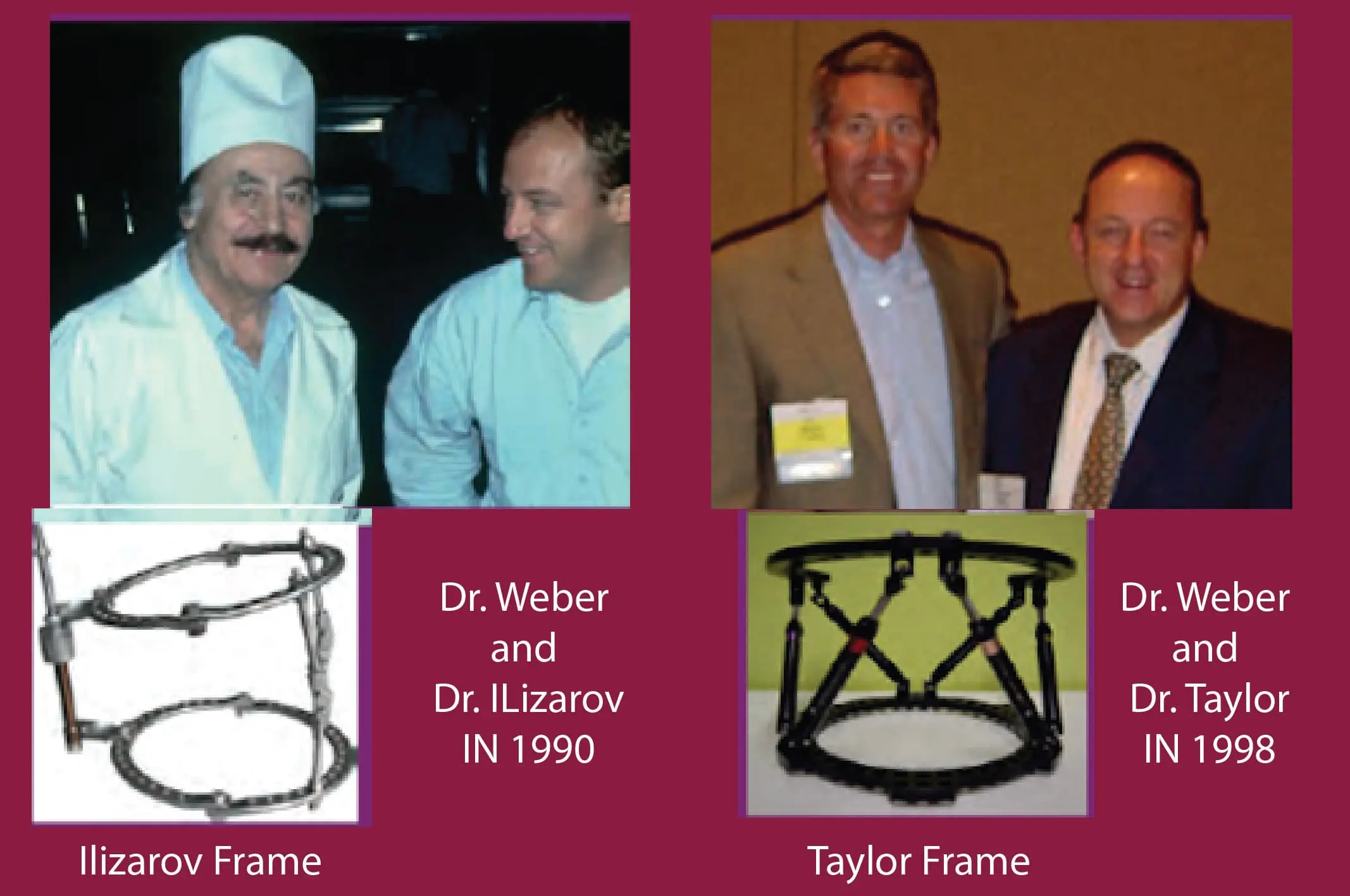
The Beginning of Limb Lengthening and Limb Reconstruction
LIMB LENGTHENING AND RECONSTRUCTION
Limb lengthening is a surgery performed by an orthopaedic doctor for gradual height increase, deformity correction and limb function ( See Fig.: Normal, Valgus and Varus axis of the legs ). This process works on the principle where the body regenerates new bones, soft tissues, ligaments, blood vessels and nerves surrounding the limb. The process begins with osteotomy, where the orthopaedic surgeon cuts the bone (generally the upper or lower leg) to be lengthened. The limb is stabilized using several external and internal fixation frames and devices. These fixators help in the gradual lengthening and correction of limbs. An external fixator is a frame built on the outside of the limb with rods, screws and wires. Internal fixation devices, on the other hand, an internal lengthening nail. It is a telescopic, motorized intramedullary nail or rod inserted into the marrow cavity of bone which is controlled by a remote-control device. With the Internal Lengthening Nail(ILN) the bones are straightened at the time of surgery and lengthening is done gradually. The muscles, blood vessels and nerves grow simultaneously as a response to the slow stretching of the limb.
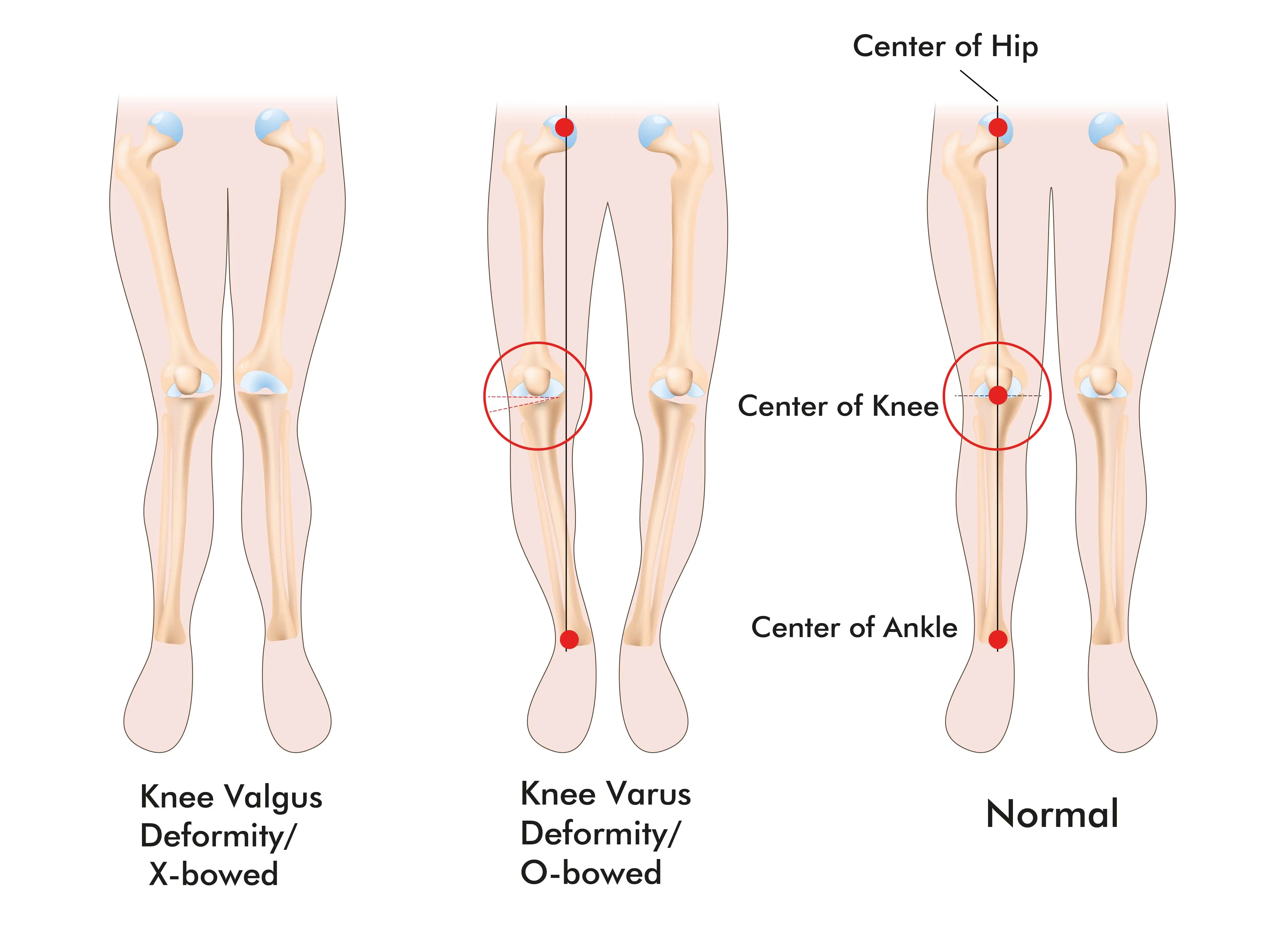
LIMB LENGTH DISCREPANCY
Limb length discrepancy is a condition where one arm or leg is shorter than the other. Lower limbs are more commonly affected than upper. This condition is known as leg length discrepancy or short-leg syndrome. It is caused by traumas or infections, poorly healed bone fractures, bone tumors or due to birth defects.
Limb lengthening surgery is a procedure that has four phases: 1. Callus production phase. 2. Callus distraction phase. 3. Callus maturation phase. 4. Equipment removal phase
- Intraoperatively the bone is cut at the planned level and depending on the area of the bone cut and the age of the patient the callus is produced at the cut between 4 to 14 days until the callus can be distracted.
- During the callus distraction the callus forms into bone (Distraction Osteogenesis) from its periphery to its centre. While the distraction the centre of the callus remains soft and allows further lengthening and deformity corrections.
- Once the distraction stops the centre of the callus ossifies and at a certain maturation time the whole callus maturated into bone. The speed of bone healing depends on the age. Children experience faster healing of bones than adults. Depending on the equipment used for the callus distraction the patient can have gradually or full weight bearing after the surgery. Once the callus is maturated full weight bearing is possible with any equipment used.
- When the callus has maturated completely the new formed bone is stable enough to remove the stabilizing equipment.
INDICATIONS FOR LIMB LENGTHENING AND OR LIMB RECONSTRUCTION
- Congenital or acquired deformities or malformations
- Congenital or acquired shortening of bones or limbs.
- Shortness of one or more limbs
- Shortness of bones at extremities hands or feet
- Shortness of hand and or foot on one side or on both sides
- Shortness of stature (cosmetic lengthening)
TYPES OF LEG LENGTHENING SURGERY AND RECONSTRUCTION SURGERY
There are mainly five different options for limb correction
A) Gradual limb lengthening and deformity correction
The procedure involves gradual limb lengthening and deformity correction by attaching an external fixator (unilateral or ring fixator) for the correction of the limb. The external fixators are fixed to the bones of the limb from outside with pins and wires. Another option for bone lengthening is using special nails implanted inside the bone in the medullary canal fixed with screws inside.
B) Epiphysiodesis
The proinciple of the surgery is to stop the growth of the bones at their growth plates. The surgery can be only performed on children whose bones are still growing. This procedure can be performed with special plates which can be removed after the limb length discrepancy is compensated and allows the growth plate to grow again. Another option is to to remove the growth plate which is a special cartilage completely for a permanent stopping of the growth at this bone end
c) Hemiepiphysiodesis
In this process, a temporary metal plate is attached to one side of the bone to halt its growth temporarily while the other side continues to grow. The surgery allows the deformed bone to straighten over time as the child grows. After the deformity is corrected the plate can be removed and the bone continues growing symmetrically
D) Acute deformity correction
This treatment involves the cutting and repositioning of bones with acute correction of the deformity. The bones are holding in corrected position by metal plates, rods, nails, wires, screws, nails or external fixators until the bone cut has healed. The deformity treatment is completed in a single surgery and doesn’t require any gradual correction. The fixation material will be removed after the bone has healed. However, not all deformities can be treated by this procedure as the nerves allow only a certain distraction before getting damaged. Therefore, to avoid nerve damage only small degrees of deformities can be corrected acutely
E) Limb shortening
Limb shortening as its name suggests is done by removing a segment of the longer bone. It can be performed in cases for limb length discrepancies of 1-4 cm.
Deformities : Deformity Correction
For correction of deformities a precisepre-operative deformity correction planning, experienced surgical performance and careful post-operative care are crucial. Minor deformity correction in children can be done by night brace, operatively with growth guidance, (8-plate, Fig. 2) and with acute correction of curved bones stabilized internally (plates, nail, rods etc.) or externally (fixators, Figs. 3, 5, 6 ,10, 11, 13, 14-17, 20).
The congenital deformities and malformations are caused due to external disturbance of limb in the womb or genetic reasons. In major deformities, callus distraction has to be done with external and internal fixators.Complex deformities in combination with severe shortening demand a stable fixation with ring fixators [17]. The main principle of callus distraction is to apply man-made growth to a bone at the location where it is needed. Therefore, the bone has to be cut and the bone fragments have to be stabilized internally (lengthening nail) or externally (fixators).
After a couple of days, the cut bone fragments attempt to heal like in a fracture. This healing tissue is called callus. After several days, the callus is formed and due to its softness, it can be distracted. With a rate of approximately 1mm per day, the bone deformity can be corrected in all axis and additionally the short bone can be lengthened. The advantage of callus distraction is that with this continuous distraction the surrounding soft tissue (muscles, vessels, nerves, tendons etc.) is growing (like in a child). The distracted and growing callus maturates by time into full quality bone.
The two main reasons of deformities are congenital (figs. 2, 5-13, 16-20) and acquired (figs. 3,4,14,15),[6,7,19-22,24,25].The congenital deformities and malformations are due to external caused growth disturbances of limb(s) in the womb of the mother (e.g., breech position, lack of amnion fluid etc.) or genetic reasons and appear usually with multiple malformations of the whole limb. Prof. Weber found that the lack of amniotic fluid was related to the fetus developing limb and joint hip dysplasia and hip luxation. Prof. Dr Weber was honoured for his discovery and awarded for his Human Oligohydramnios-Sequence-Model for hip dysplasia and luxation at the 22 SICOT Conference in Sydney, Australia in 2002.
The acquired deformities are the result of incorrect fracture healing or damage to the growth plate, bone and joints in childhood due to injury, disturbance of the blood support, paralysis or spasticity of muscles or weakening of the bone due to Vitamin-D deficiency (very common in UAE) which can lead to the typical O or X-curved legs. In adult’s deformities occur mainly due to injuries of bone and joints with fracture healing problems like persisting deformities, delayed or non-union of the bones. Many adults also suffer from persisting deformities since childhood. In childhood, minor deformities can be treated conservatively with night braces or operatively with small surgeries using special plates for the guidance of growth at the growth plates. In major deformities or deformities with additional bone shortening, callus distraction has to be performed with external fixators or internal methods like lengthening nails. The following pictures are giving few examples of different reasons and techniques for the treatment of deformities, defects and malformations
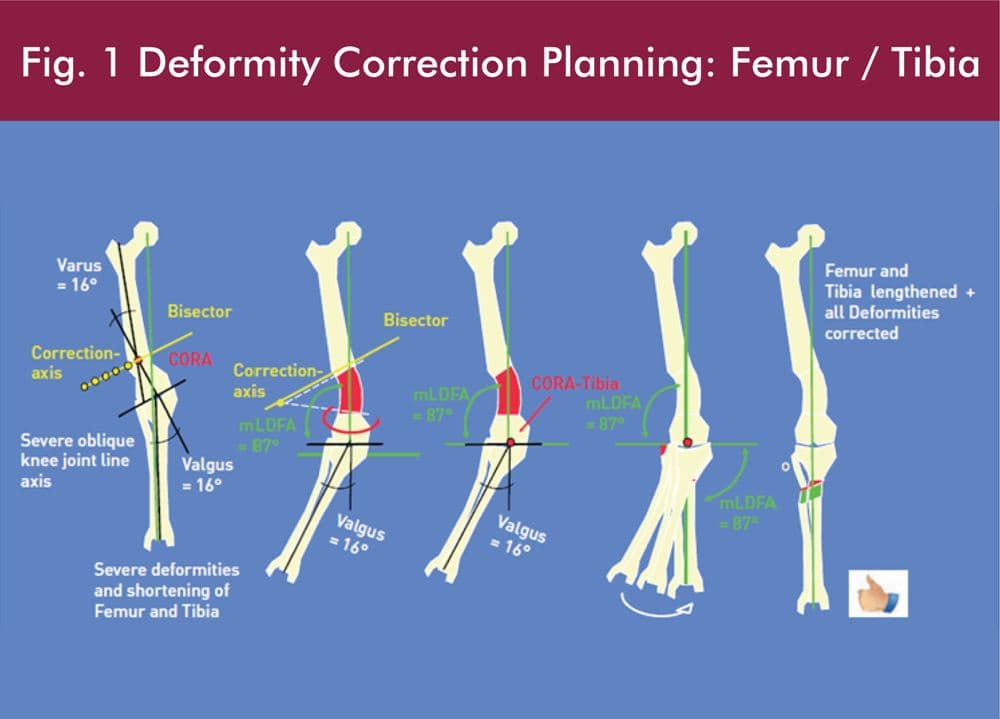
Fig. 1 A precise deformity correction planning is crucial for successful outcome of surgery

Fig.2 (a) Both legs have valgus deformity along with additional shortening in the right leg.
(b-c) The left side is treated with growth guidance by an 8-plate that temporarily stops the growth at the side of the application while inserted.
(d) After achieving the required results, the plates can be removed and the growth of the side plate resumes. Full weight-bearing is possible at all times. The right leg also has a shortening besides valgus deformity, requiring a combination of deformity correction and limb lengthening with a fixator via callus distraction.

Fig. 3 (a) After tibial growth plate injury in childhood at the ventral proximal tibia this adolescent suffered from a severe recurvatum deformity of the tibia combined with a flexion contracture of the knee.
(b) Both conditions can be corrected with two connected Taylor Spatial Frames (TSF). The upper TSF corrects the knee flexion contracture and subluxation by soft tissue and the lower TSF corrects the tibial recurvatum deformity with callus distraction. The TSF allows full weight-bearing during the treatment.
(c) Clinical picture aftercomplete correction
(d) X-Ray showing severe osseous recurvatum deformity before surgery.
(e) X-Ray showing perfect axis after correction with good callus formation.
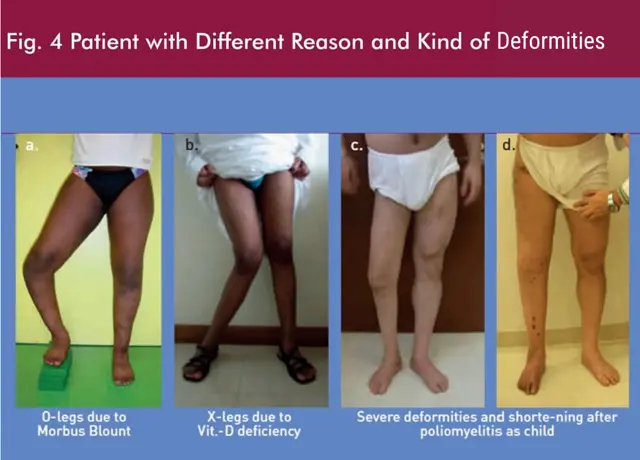
Fig.4 (a) An 11-year-old girl with severe O-curved legs of the same degree on both sides due to Morbus Blount. She was treated successfully with TSF of the left leg.
(b) A young man with severe X-curved legs of the same degree on both sides due to Vitamin-D deficiency in childhood. He was treated with ring fixators successfully of the left leg.
(c) A man suffering from severe shortening and deformities of the right leg due to poliomyelitis in childhood. Note the tilted pelvic line.
(d) Same patient (fig.4c) after correction of the shortening and all deformities. Note the pelvic line. He can walk without his brace now.
Malformation (Birth defects)
Longitudinal Reduction Deficiencies like Tibial Hemimelia or Fibular Hemimelia represents rare birth defects where the leading bone structure is either the tibia or the fibula(figs.2, 5-11). Both types of malformations have their special characteristics with leg length discrepancies, deformities, instabilities, and malfunctions. In this, the surgery is done not only for a part but the whole leg and body to get body balance and best functions.
The treatments have to be adapted to the growing child and require often a multi-step procedure during childhood.
In the following presentation only a few examples of Prof. Weber’s proprietary techniques can be presented demonstrating the extraordinary possibilities of limb reconstruction and lengthening and especially the construction of limbs and joints to improve the limb function to its best.
Malformation: Malformation Severe type of Fibular Hemimelia
Fibular Hemimelia (fibular reduction deficiency is a rare type of malformation with an occurrence chance of 1 in 40,000 births. The main problems associated with this birth defect is that depending on the severity of this disease additional deformities and instabilities occur around the hip, knee, ankle and foot as well as limb length discrepancy. Especially the severe form of this disease requires a treatment concept of the entire leg to achieve good results. Here are some examples:

Fig.5 (a) Severe type of fibular hemimelia with severe shortening, tibial deformity and ankle instability.
(b-c) Osseous wedge osteotomy with reverse transplantation of bone-wedge above the oblique tibial growth plate giving an acute correction of the tibial deformity and ensuring further straight growth of the tibia due to acute correction of the ankle joint line axis.
(d) Simultaneous lengthening at the proximal tibia.
(e) The acute wedge correction and lengthening of the tibia is supported by a mini-ring-fixator, a smaller version of fixator allowing treatment also on infants. Prof. Weber was the first who used the mini-ring-fixator in Germany. This picture shows the fixator after 10 cm lengthening and before removal. The anchor wire and central tibia wire fixating the wedge osteotomy was removed already.
Prof. Weber invented a unique technique to create a lateral malleolus that is missing in severe types of fibular hemimelia to prevent a luxation of the foot during lengthening or to treat severe ankle instability. In this technique, a triangular free iliac crest transplant with adhering gluteal fascia is mobilised from the patient’s iliac crest and transplanted into the missing lateral malleolus of the ankle joint. The transplant with the apophysis (cartilage which is responsible for growth) ensures further temporary growth (in average 3 years). The defect at the iliac crest is healed itself. The transplanted gluteal fascia is working as stabilizing the lateral ankle tendon. The advantage of the procedure is that it gives permanent stability to the ankle joint for the lengthening and during the further growth of the leg. No luxation has been observed after this procedure.
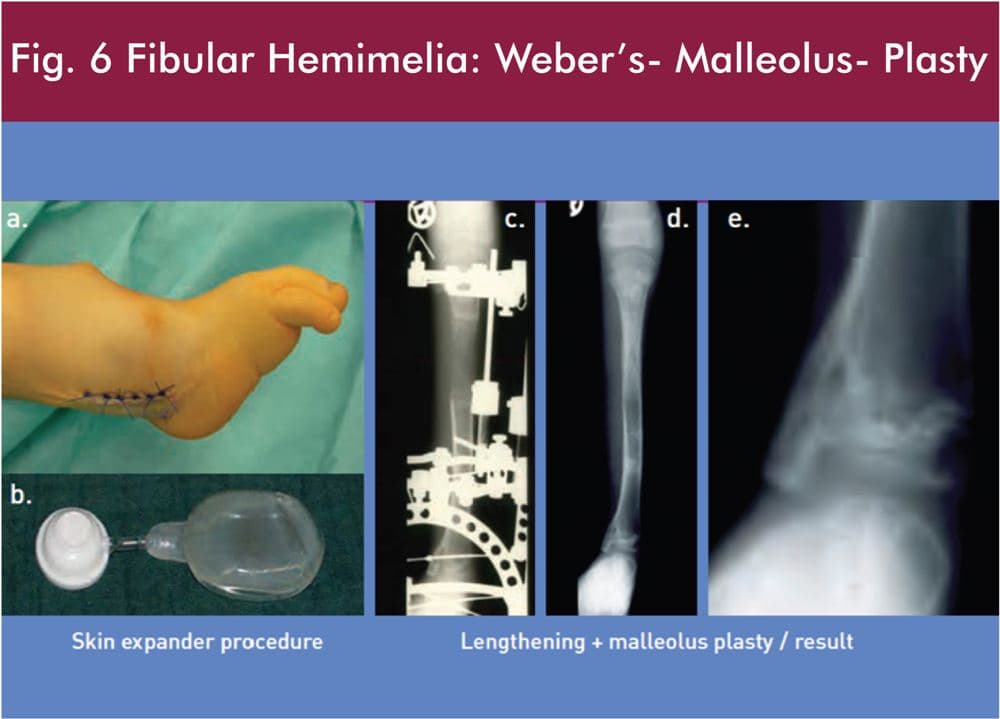
Fig.6 To prevent a luxation of the foot during lengthening or to treat a severe ankle instability, Prof. Weber invented a unique technique to create a lateral malleolus which is missing in severe types of fibular hemimelia or if present it is not sufficient enough [8]. For this technique a triangular free iliac crest transplant with adhering gluteal fascia is mobilized from the patient’s iliac crest and transplanted into the missing lateral malleolus of the ankle joint. The transplant with the apophysis (cartilage which is responsible for growth) ensures further temporary growth (in average 3 years, upto 5 years). The defect at the iliac crest is healing by itself. The transplanted gluteal fascia is working as a stabilizing lateral ankle tendon. The advantage of this procedure is that it gives permanent stability to the ankle joint for the lengthening and during the further growth of the leg. No luxation has been observed after this procedure
(a) Incision is made to implant a skin expander.
(b) With a skin expander the skin can be expanded by filling the balloon with fluid through a syringe. With the needle of the syringe, the port (white rubber circle) of the skin expander is punctured every week and a certain volume is applied. Usually, after six weeks the skin has grown enough to cover the transplant.
(c) X-ray: Ongoing lengthening with ring fixator after malleolus transplantation.
(d) X-ray: Tibial bone after deformity correction, malleolus transplant and 10 cm lengthening.
(e) X-ray: Detail of malleolus transplant at ankle joint.

Fig.7 The foot has no normal joint between talar and calcaneal bone but a solid osseous fusion. This leads beside a missing motion in the lower ankle joint to a lateral shift of the foot with a severe imbalance of the mechanical axis. Additionally, the joint line of the ankle is about 15 degrees’ oblique which increases the axis problem.
(a) Frontal X-ray of the foot and ankle with the described malformation and deformities.
(b) For treatment of the talocalcaneal fusion, the bony bridge between the talus and calcaneus is cut and the calcaneus shifted into the corrected position
(c-d) The upper ankle joint shows a valgus deformity of 15 degrees.
(e) With a dome osteotomy, the deformity is corrected acutely. All corrections are done with a TSF application where all deformities were corrected and the lower limb leg discrepancy equalized. The clinical pictures are shown in Fig. 8.
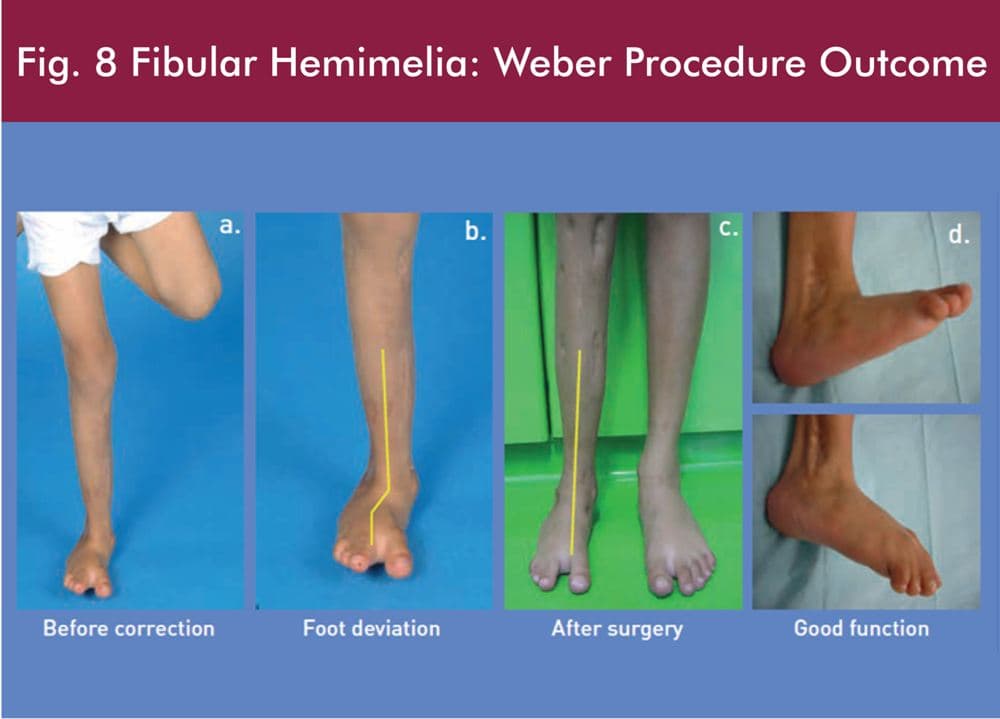
Fig. 8 (a) This patient has undergone a Weber-Malleolus-Plasty, deformity correction of the tibia and 10 cm lengthening of the lower limb before. (b) The foot and ankle show the deformities described above.
(c) After correction of ankle deformity and the talocalcaneal fusion including, the second lengthening of 7 cm the foot is perfectly aligned with the mechanical axis of the leg and the leg length discrepancy is equalized.
(d-e) The range of motion of the upper ankle joint is very good.
Malformation : Weber’s Transformation surgery for treatment of Tibial Hemimelia
Tibial Hemimelia(tibial reduction deficiency)is another rare birth defect (1/1,000,000 births) characterised by different amounts of tibial bone reduction. This malformation can occur with or without a cartilaginous anlage or without. According to the occurrence of the tibial missing part of the adjacent joint is missing too. For the new construction of the joint Dr Weber (the first one to use this technique) uses cartilaginous anlage with extraordinary results [Booster-Technique, 1,4]. The most severe form Type VII-B according to Weber-Classification shows a lower leg with complete lack of the tibial bone. The disease is the most challenging to treat for an orthopaedist and is categorised under congenital malformation. Dr Weber has been awarded by the German and the European Society for paediatric orthopaedics for inventing a worldwide unique technique that prevents limb amputation by transforming the patella to a knee and the fibula into a tibia (Transformation Surgery). With this world-wide unique techniques, the patients are able to walk and do sports [1,4,10]. According to Prof. Weber’s classification all 12 different types of this disease can be treated successfully with different Weber-Special- Techniques. Dr Weber has treated the most patients worldwide suffering from this rare disease.

Fig. 9 Prof. Weber’s classification of Tibial Hemimelia [3] with the main twelve different types according to the severity of the malformation and respecting the cartilaginous anlage discovered by Prof. Weber (black = bones; blue = cartilaginous anlage)
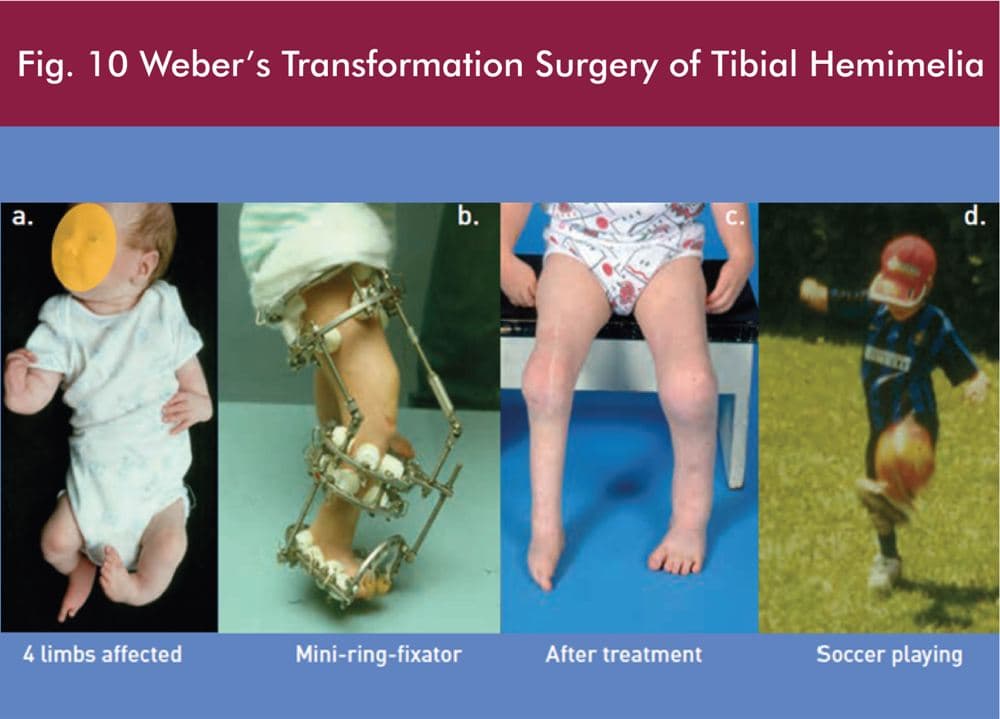
Fig. 10 (a) The child has all four limbs malformed.
(b) After lengthening with a Mini-Ring-Fixator and performing the Weber-Transformation-Surgery (patella is used as a tibial plateau, the fibula is used as the tibia) for creating a knee joint and a tibia on the right leg the patient has full weight-bearing with a very good range of motion.
(c) The affected left leg was also treated successfully Worldwide this technique is the only procedure preventing lower extremity limb amputation in children suffering from type VII-b Tibial Hemimelia.
(d)The treatment of the hands was performed later and the boy was able to play soccer after that.
Malformation : Weber’s Booster Surgery for Treatment of Tibial Hemimelia
The use of the cartilaginous anlage (remnant of tibia made of cartilage) in tibial hemimelia is a breakthrough in the construction of missing joints and recovery of the original growth plates. In this procedure, the cartilaginous anlage of the malformed tibia is shifted by bone lengthening methods until the adjacent joint comes together. Due to this manoeuvre, the cartilaginous anlage develops a joint and its own growth plate maturate. This principle applies to all types of tibial hemimelia with cartilaginous anlagen After Dr Weber’s procedure further own growth of the tibia can be expected
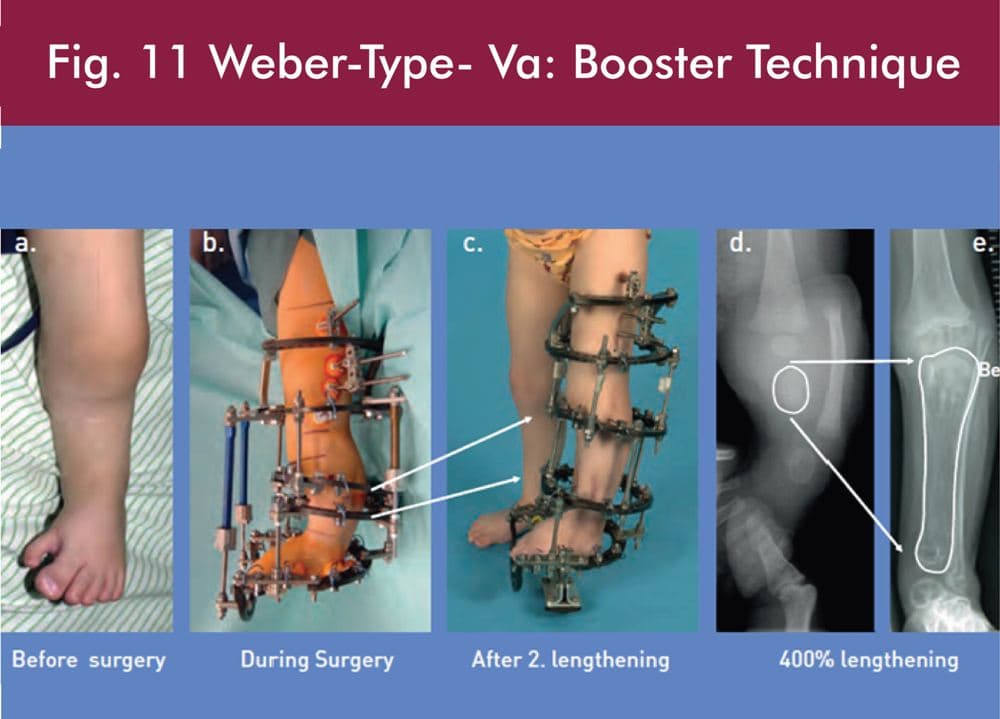
Fig. 11 (a) The malformed leg and foot before surgery.
(b-c) Ring fixators are used for stabilizing the leg during the lengthening process.
(d-e) The X-rays show the creation of knee and ankle joint including 400% lengthening of tibial remnant after two lengthening’s by Weber’s Booster Technique. Growth plates are developing during Dr Weber’s procedure ensuring further natural tibial growth
Bone Defect : Internal Bone Transport with Weber-Cable-Technique
Defects in bones can occur due to injury, surgical resection, death of bone and tumors. The basic technique involves filling of bone defect with external bone transport with callus distraction. During external bone transport, the wires and half pins are used for fixing through soft tissues. This is a painful procedure. Weber-Cable -Technique is a substitute for the above painful procedure. In Weber-cable-Technique, transported bone segments are fixed internally with cables and pulled internally without any damage to the soft tissues until the bone defect is closed. The patient doesn’t feel anything of the bone transport. Prof. Weber received the Medical-Orthopaedic- Technique Award for his achievement in Germany.
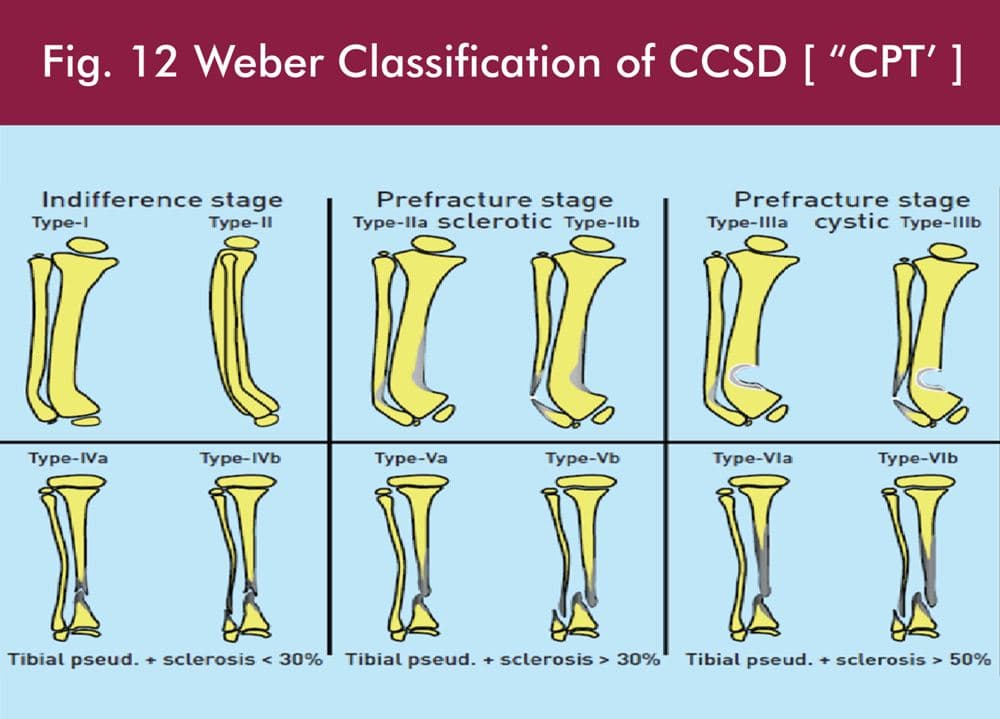
Fig. 12 The Congenital Crural Segmental Dysplasia (CCSD, also called congenital tibial pseudarthrosis) is one of the most challenging diseases in paediatric orthopaedics. In the literature you will find that most of the cases were treated unsuccessfully more than 20 times and are often ending with amputations [9,12]. One of the reasons for insufficient results is that this disease is misdiagnosed[13] as a normal fracture in childhood. Own researches have shown that the periosteum (bone skin) which is normally responsible for bone growth and nutrition shows severe pathological changes not fulfilling any longer this task. The blood supply and nutrition of the bone are disturbed by the pathological periosteum which weakens the bone until it gets fractured. Additionally, this pathological periosteum prevents the fractured bones from healing. In Germany, Prof. Weber has treated most cases with a success rate of over more than 95%. The reason for the excellent result lies in a well-defined treatment concept that originates from the results of the researches according to the origin of the disease as well as its proprietary techniques[2,5].In Dr. Weber’s classification (Fig. 12) the main different types of CCSD are represented with the focus on appropriate treatment options regarding each different type. For the first time in the literature the importance of the fibula is respected. Type a represents an intact fibula, type b represents a broken fibula.
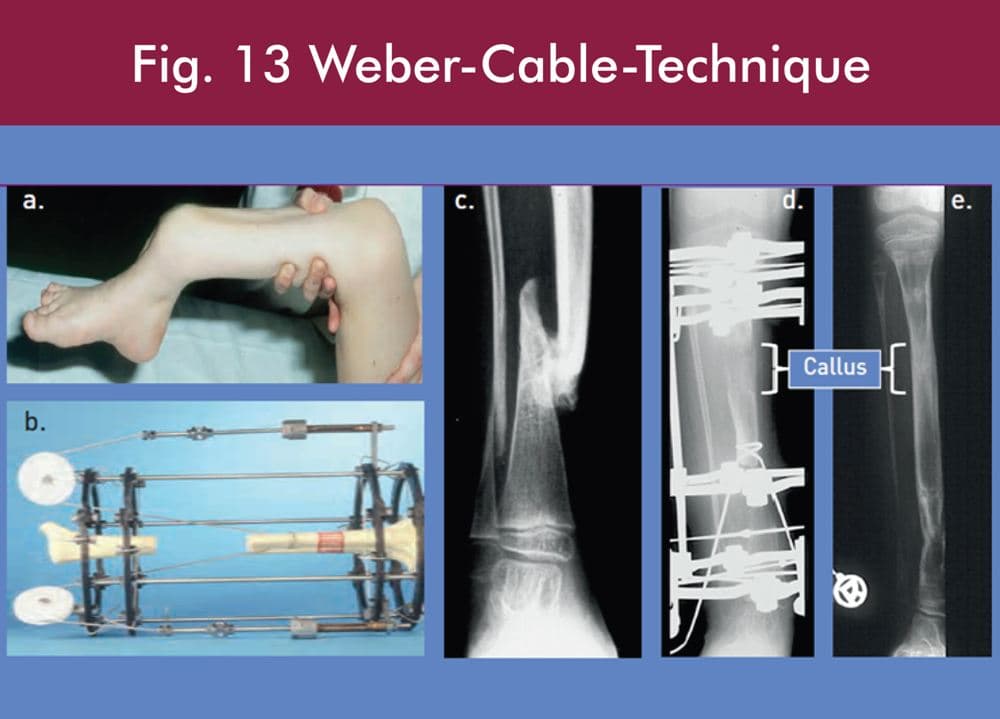
Fig. 13 (a) A 5-year-old boy suffering from a Type-Vb CCSD with fracture and pseudarthrosis of the fibula and tibia.
(b) The model shows the principle of the Weber-Cable-Technique. A cable is attached to the bone segment which will be transported and directed internally along with the bones and led out to pulleys. These pulleys redirect the cable to distractors mounted on the ring fixator. By turning the distractors, the mobilized bone segment can be transported internally (1mm/day) after a callus (red) has formed. The transport is stopped when the bone defect is closed. The callus will maturate into normal high-quality bone tissue. The docking of the transported bone segment with the opposite bone heals like a fracture.
(c) X-Ray showing fracture and pseudarthrosis of the lower leg.
(d) X-ray of ongoing cable transport before docking. Good callus formation.
(e) X-ray showing complete permanent healing of the pseudarthrosis.
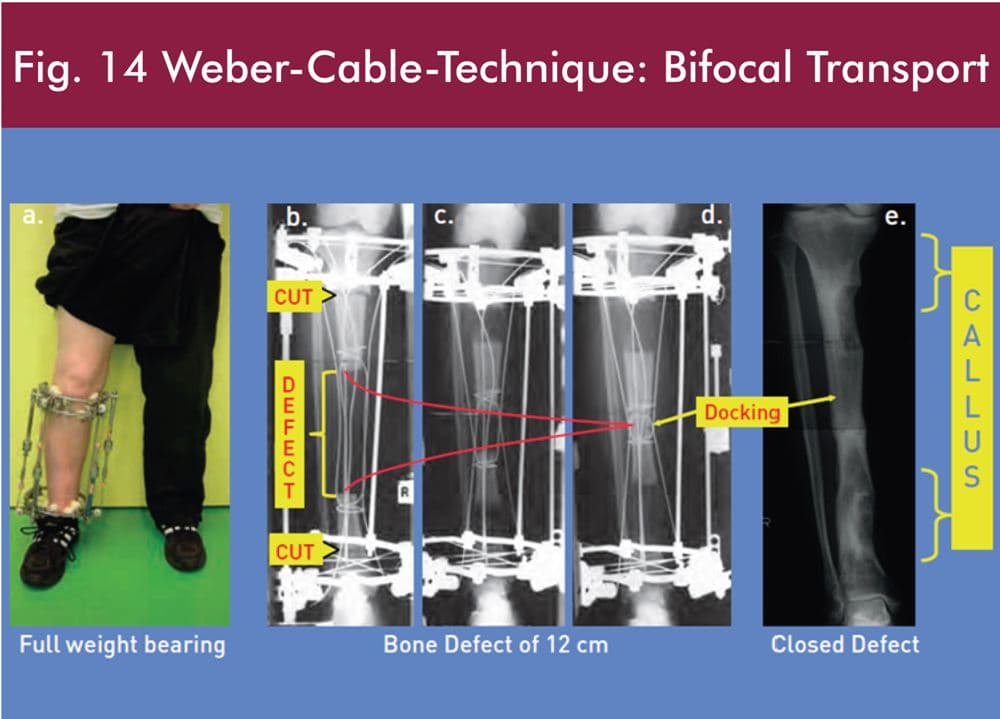
Fig. 14 (a) The patient undergoing the bone transport after resection of a bone tumour can have the full weight bearing on the leg because the bone fragments are stabilized with a ring-fixator (patients with ring-fixators can walk, go to school or university, do household work or work in an office etc.).
(b) The X-ray picture shows the two bone cuts to mobilize both bone segments for bifocal transport and the bone defect of 12 cm is closed in 60 days. At these bone cuts, the bone attempts to heal by producing a healing tissue called callus. This callus is soft and can be extended.
(c-d) With the attached cables at both bone ends the bone segments can be pulled towards each other at a growth rate of 1mm a day. Once the bone ends have reached each other (docking) the transport is stopped and the bone can heal together at the docking area.
(e) In the gaps of distraction, the callus produced by the bone maturates to high-quality own bone tissue
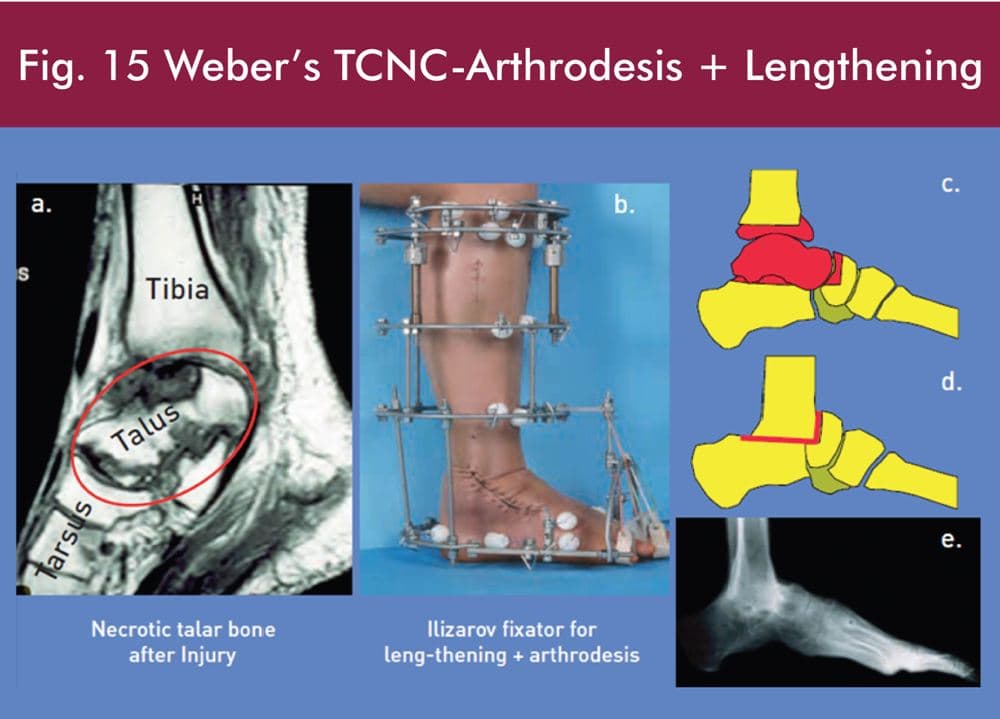
Fig. 15 (a) This young man had a severe sports injury with damage to his talar bone. In the following years, he developed necrosis of the complete bone and cartilage so that it had to be removed. With Weber’s TCNC-Arthrodesis it is possible to give the foot stability again and to enable the patient full weight-bearing and to return to sports.
(b) With the ring fixator, the tibial bone can be osteo-synthesized to the calcaneal, navicular and cuboidal bone after resection of the talus. Additionally, with the fixator, the resulting shortening of the bone can be equalized by lengthening the tibia simultaneously.
(c) Schematic drawing of the resection of the talus and affected joint cartilage.
(d) TCNC-Arthrodesis. e. Postoperative X-ray of the successful Arthrodesis. Prof. Weber’s TCNC-Arthrodesis was awarded during the 22nd SICOT Conference in Sydney, Australia. This proprietary technology can be used to prevent amputations in all ailments where the talus has to be removed due to infection after failed ankle arthrodesis, necrosis due to trauma or in the diabetic foot, tumor, neurological or congenital diseases for stabilizing the foot[11,16]..
Foot Problems: Growth disturbances of rays
The underdeveloped bones in the feet are usually congenital. Single or multiple bones can be affected and, in some cases, the whole leg can show malformations. The problem with a patient with hypoplasia of the foot is that the normal structure of the foot is disturbed leading to improper weight distribution and imbalance.Additionally, the normal digits grow into the gap of the shortened digit. These can lead to second deformities, pain and inability to wear normal shoes. Conservative treatments with custom made insoles can help to reduce the complications of this foot problem. The original problem of the shortened bone can be treated better by lengthening the affected bone. Once the correct length is achieved the foot has its normal architecture, the weight load is balanced and no secondary deformities of the other digits can occur.

Fig. 16 (a) A young lady who suffered from a birth defect of her fourth metatarsal bone. Due to its shortening, the healthy digits are shifting already into the resulting gap. This leads to pain and problems with shoe wearing. See the interrupted midfoot arch line (red wave).
(b) After cutting the bone in the midshaft a mini-ring-fixator is applied to perform the lengthening.
(c) The X-ray shows the corrected length of the toe and midfoot arch. The patient can wear normal shoes and do sports. The development of secondary deformities of the healthy digits is prevented

Fig. 17 (a) X-ray, this 7-year-old boy was suffering from a complete malformation and hypoplasia of the first ray left (red arrow). The digits 2 – 5 are deviating into the gap of the short first ray (white arrows).
(b) After realignment of the three bone segments of the first ray, the metatarsal bone is lengthened with a mini-ring-fixator.
(c) The X-ray shows the reconstructed first ray with corrected length. The toe deviation 2-4 have started correcting itself.
(d) The result after removal of the fixator
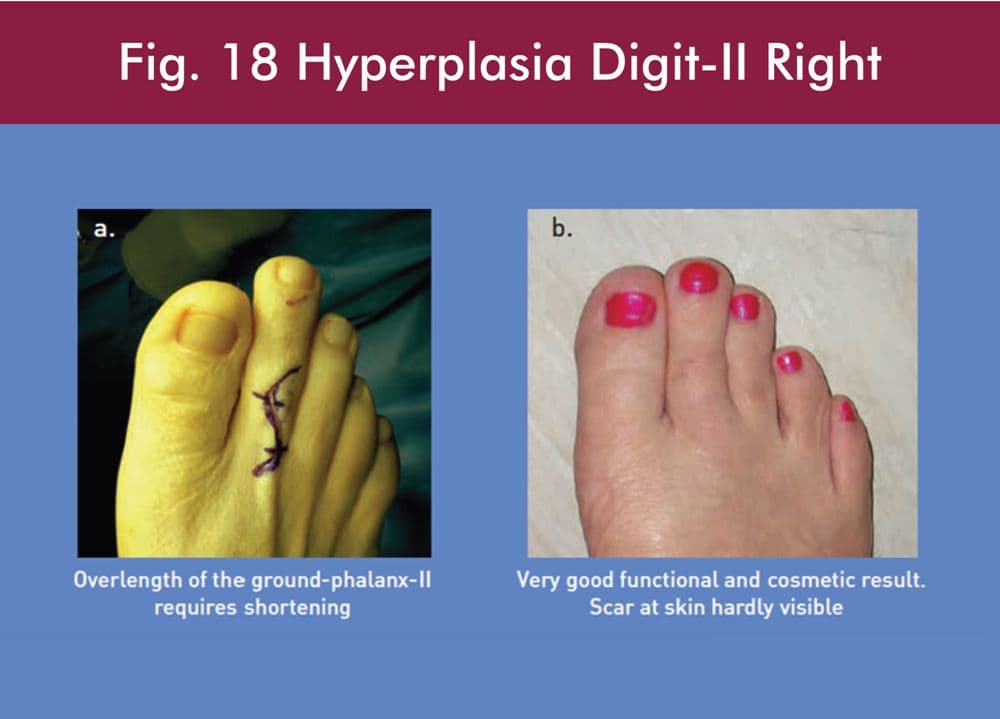
Fig. 18 (a) The over-length of digit two of this female patient leads to severe problems wearing shoes resulting in pain and the risk of craw-toe development, besides the cosmetic problem.
(b)After resection of a bone segment at the ground-phalanx of digit-II (s-shape skin incision), the patient has no more problems wearing shoes and is very happy with the cosmetic result(b)..
Foot Problems : Clubfoot
The clubfoot is typically present by birth and can affect one or both feet and can be a part of longitudinal reduction deficiency like tibial hemimelia or tibial deformity. It is a general term used for reasons, characteristics and appearance of typical deformities. The utmost importance for a successful treatment is to start treatment at the earliest to address the origin of the deformity, as the newborn tissues are soft and immediate treatment after birth with repetitive stretching and keeping the corrections arrested in special casts (Ponseti-technique) guarantees the best results with less invasion. Thus, the older the patient, the more rigid the clubfoot, the more invasive treatment required.

Fig. 19 Schematic drawing shows the different treatment options of clubfoot according to the age of the patient and the severity of disease which Prof. Weber is performing successfully for 24 years. If the patient is treated immediately after birth in most cases the foot can be corrected with several casts according to the Ponseti method and only minor surgeries like Achilles’ tendon lengthening is needed. So much older the patients, so more rigid the deformity, so more invasive the surgery. These surgeries range from peritalar release to fixator treatment without or with osteotomies of the deformed foot bones. During all different kinds of treatments, physiotherapy is always included in the treatment concept as well as custom made special braces to reduce the risk of reoccurrence.

Fig. 20 (a-b) This seven-year-old boy suffered from severe deformed neurological clubfeet due to spina bifida. His feet were twisted and he was walking on the back of his feet.
(c) The ring fixator treatment was done according to the principles of the Ponseti method correcting the different deformities step by step with several pain-free re-mountings of the fixator in the outpatient clinic.
(d) The postoperative result is perfect. For prevention of recurrence of club foot and to compensate the paralyzed feet muscles the patient has to wear a stabilizing inner shoe.

Fig. 21 Beside the versatile surgical treatment of a very much experienced Orthopaedic Surgeon the positive patient treatment outcome depends on best treatments and a continuous support cycle process that includes the joint contributed efforts of the Orthopaedist, the parents or patients and the multiple disciplinary team.
Adam Vital is the best orthopaedic and sports medicine hospital with the best pediatric orthopaedic surgeon in Dubai. Our team of orthopaedic foot specialists and traumasurgeons will provide you with the best care and excellent treatment for all kinds of musculoskeletal problems including, limb lengthening and limb reconstruction.
References :
1. Weber, M.: Treatment of Tibial Hemimelia in M. Kocaoğlu et al. (eds.), Advanced Techniques in Limb Reconstruction Surgery, Springer Berlin Heidelberg, 2015
2. Weber, M.: Congenital Pseudarthrosis of the Tibia: Redefined (Congenital Crural Segmental Dysplasia) in M. Kocaoğlu et al. (eds.), Advanced Techniques in Limb Reconstruction Surgery, Springer, Berlin Heidelberg,2015
3. Weber M.: New classification and score for tibial hemimelia. J Child Orthop (2008) 2:169-175
4. Weber, M.: Congenital Leg Deformities: Tibial Hemimelia in S.R. Rozbruch and S. Ilizarov (eds.), Limb Lengthening and Reconstruction Surgery, Informa Healthcare, New York, 2007
5. Weber, M.: Congenital Pseudarthrosis of the Tibai. Redefined: Congenital Crural Segmental Dysplasia in S.R. Rozbruch and S. Ilizarov (eds.), Limb Lengthening and Reconstruction Surgery, Informa Healthcare, New York, 2007
6. Hermanns B., Senderek, J., Füzesi, L., Weber, M.: Periostal proliferations in bone lesions of congenital pseudarthrosis of the tibia have morphological features of neurofibromatosis type-I. Pathology in Research and Practice (2004)
7. Hermanns, B., Senderek, J., Klosterhalfen, B., Stemper, A., Büttner, R., Weber, M.: Malexpression of Hox c11 causes fibular a- or hypoplasia (FAH) in humans? Pediatr Dev Pathol (2004)
8. Weber, M.: Siebert, C.H., Goost, H., Johannisson, R., Wirtz, D.: Malleolus externus plasty for joint reconstruction in fibular aplasia: Preliminary report of a new technique. J PediatrOrthop (B) 11: 1-11 (2002)
9. Weber, M.: Neurovascular calcaneo-cutaneus pedicle graft for stump capping in congenital pseudarthrosis of the tibia: Preliminary report of a new technique. J PediatrOrthop (B) 11: 47-52 (2002)
10. Weber, M.: A new knee arthroplasty versus Brown´s procedure in congenital total absence of the tibia: A preliminary report. J PediatrOrthop (B) 11: 53-59 (2002)
11. Weber, M., Schwer, H., Zilkens, K.W., Siebert, Ch.: The tibio-calcaneo-naciculo-cuboidale (TCNC) arthrodesis. - A new technique for treatment of difficult talar pathology -. Acta OrthopScand 73: 98-103 (2002)
12. Weber, M.: Eine neue Technik der Stumpfkappenplastik am Unterschenkel. Orthopädie – Technik 4:240-246 (2001)
13. Mahnken, A.H., Staatz, G., Hermanns, B., Gunther, R.W., Weber, M.: Congenital pseudarthrosis of the tibia in pediatric patients: MR Imaging. Am J Roentgenol 177: 1025-1029 (2001) 20
14. Weber, M., Schwer, H.: Der diabetischeFuß- Eine interdisziplinäreHerausforderung. Z Orthop 139: 54-55 (2001)
15. Weber, M., Siebert C.H., Heller, K.D., Birnbaum, K., Kaufmann, A.: Segmental transport utilizing cable wires and pulleys mounted on an Ilizarov frame – A new technique-. J Bone Joint Surg (Suppl.) 81-B: 148 (1999)
16. Weber, M., Schwer, E.H., Siebert, C.H.: FokussanierungeinerchronischsequestriertenTalusosteomyelitis durch die TCNC (tibio - calcaneo - naviculo - cuboidale) Arthrodese. Eine neue Technik am Ringfixateur. Unfallchirurg 102 402-405 (1999)
17. Schwer, E.H., Siebert, C.H., Kaufmann, A., Wilke, M., Weber, M.: Indication of change from unilateral to Ilizarov ring fixator. J Bone Joint Surg (Suppl.) 81-B: 148 (1999)
18. Weber, M.: Segmenttransport des KnochensmittelsKabelrollen und flexiblemDraht – Eineneue Technik am Ringfixateur-. Med Orth Tech 118: 134-140 (1998)
19. Weber, M.: Wenz, W., van Riel, A., Kaufmann, A., Graf, J.: Das Holt-OramSyndrom (HOS). – Literaturüberblick und aktuelleorthopädischeBehandlungskonzepte-Z Orthop 135: 368-375 (1997)
20. Axt, M. W., Niethard, F. U., Döderlein, L., Weber, M.: Principles of treatment of the upper extremity in arthrogryposis multiplex congenital type I. J PediatrOrthop (B) 6: 179-185 (1997)
21. Spranger, S., Weber, M., Tröger, J., Tariverdian, G., Opitz, J.M.: Bilateral radial deficiency with lower limb involvement. Am J Med Genet 63: 193-197 (1996)
22. Merkelbach, H., Carstens, C., Weber, M.: OrthopädischeProblemebeim Morbus Down. MonatsschrKinderheilkd 144: 778-785 (1996)
23. Weber, M.: Johannisson, R., Bos, I., Schröder, S., Rehder, H.: Oligohydramnios sequence as human morphological model of hip dysplasia and luxation. SICOT/SIROT XXII World Congress, 25.-30. August in San Diego, USA (Poster) Abstractbook: S. 583, P 1634 (2002)
24. F.U. Niethard, M. Weber, K.-D. Heller (eds.): Orthopaedie compact. Thieme, Stuttgart, New York, 2005
25. Rehder, H., Weber, M., Heyne, K., Lituania, M.: Fetal Pathology – Nonchromosomal in E.F. Gilbert, J.M. Opitz (eds.) Genetic Aspects of Developmental Pathology, Alan R. Liss, Inc., New York, 1987

